light control module BMW 528I 1998 E39 Central Body Electronics ZKE Manual
[x] Cancel search | Manufacturer: BMW, Model Year: 1998, Model line: 528i, Model: BMW 528i 1998 E39Pages: 80, PDF Size: 4.14 MB
Page 3 of 80
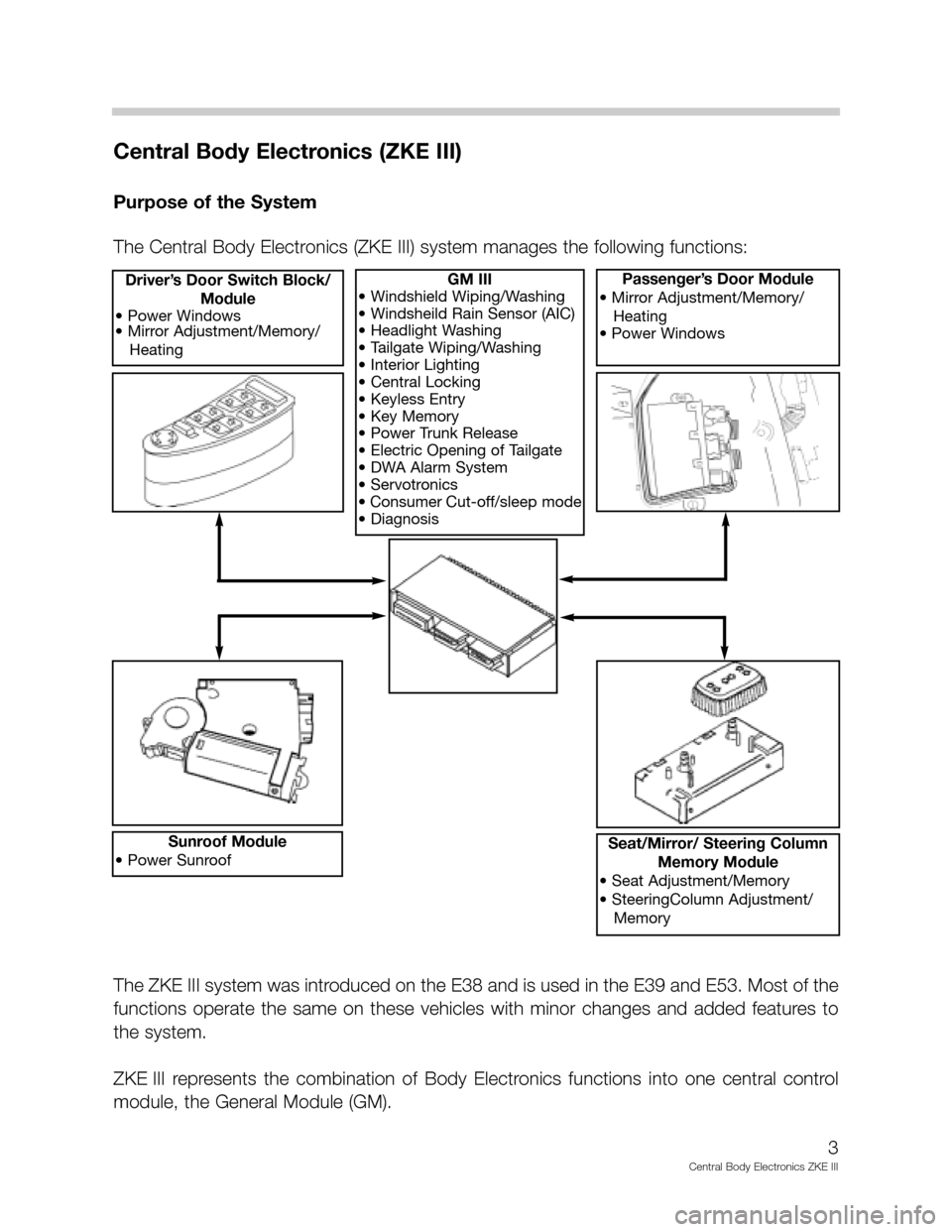
3
Central Body Electronics ZKE III
Central Body Electronics (ZKE III)
Purpose of the System
The Central Body Electronics (ZKE III) system manages the following functions:
GM III
• Windshield Wiping/Washing
• Windsheild Rain Sensor (AIC)
• Headlight Washing
• Tailgate Wiping/Washing
• Interior Lighting
• Central Locking
• Keyless Entry
• Key Memory
• Power Trunk Release
• Electric Opening of Tailgate
• DWA Alarm System
• Servotronics
• Consumer Cut-off/sleep mode
• DiagnosisDriver’s Door Switch Block/
Module
• Power Windows
• Mirror Adjustment/Memory/
HeatingPassenger’s Door Module
• Mirror Adjustment/Memory/
Heating
• Power Windows
Sunroof Module
• Power SunroofSeat/Mirror/ Steering Column
Memory Module
• Seat Adjustment/Memory
• SteeringColumn Adjustment/
Memory
The ZKE III system was introduced on the E38 and is used in the E39 and E53. Most of the
functions operate the same on these vehicles with minor changes and added features to
the system.
ZKE III represents the combination of Body Electronics functions into one central control
module, the General Module (GM).
Page 13 of 80
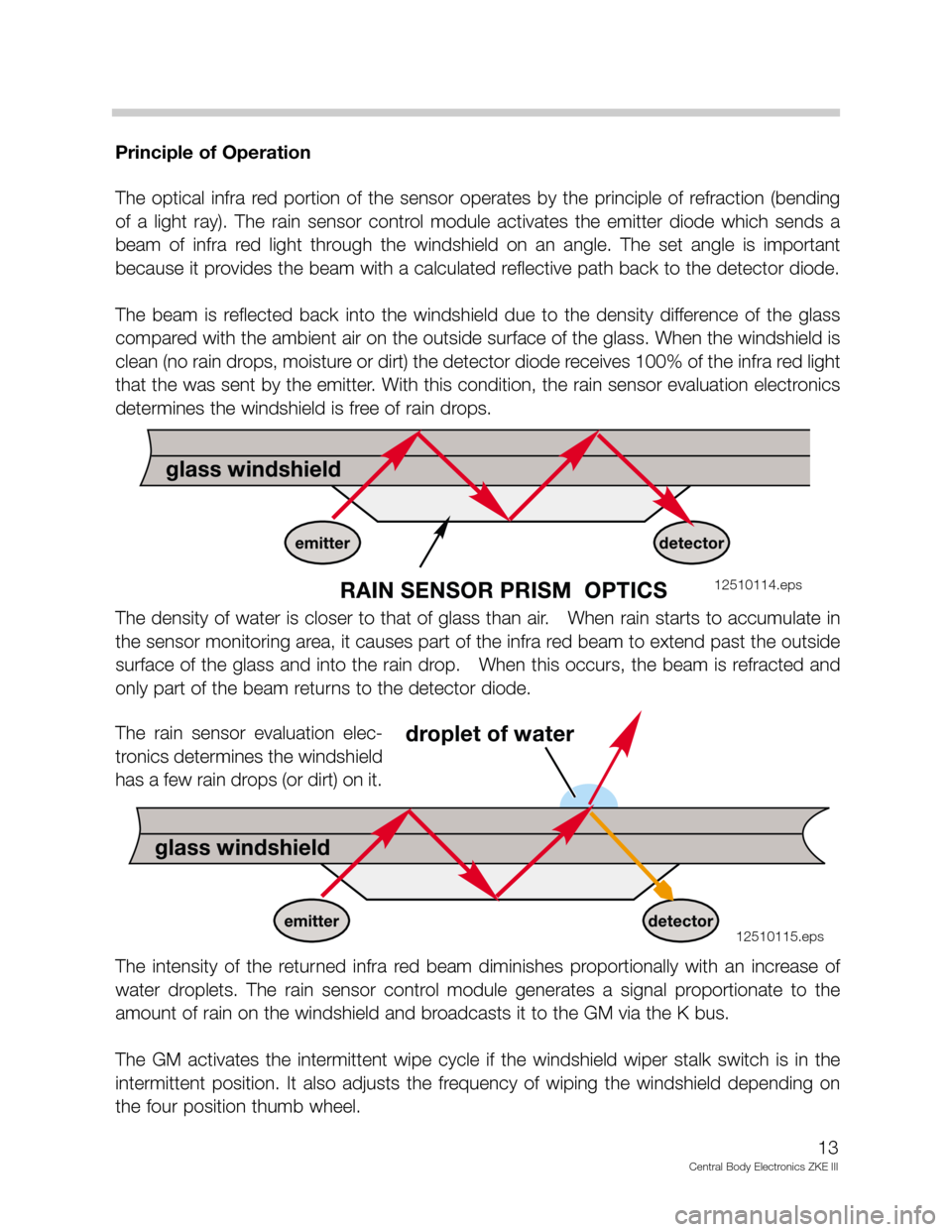
13
Central Body Electronics ZKE III
Principle of Operation
The optical infra red portion of the sensor operates by the principle of refraction (bending
of a light ray). The rain sensor control module activates the emitter diode which sends a
beam of infra red light through the windshield on an angle. The set angle is important
because it provides the beam with a calculated reflective path back to the detector diode.
The beam is reflected back into the windshield due to the density difference of the glass
compared with the ambient air on the outside surface of the glass. When the windshield is
clean (no rain drops, moisture or dirt) the detector diode receives 100% of the infra red light
that the was sent by the emitter. With this condition, the rain sensor evaluation electronics
determines the windshield is free of rain drops.
The density of water is closer to that of glass than air. When rain starts to accumulate in
the sensor monitoring area, it causes part of the infra red beam to extend past the outside
surface of the glass and into the rain drop. When this occurs, the beam is refracted and
only part of the beam returns to the detector diode.
The rain sensor evaluation elec-
tronics determines the windshield
has a few rain drops (or dirt) on it.
The intensity of the returned infra red beam diminishes proportionally with an increase of
water droplets. The rain sensor control module generates a signal proportionate to the
amount of rain on the windshield and broadcasts it to the GM via the K bus.
The GM activates the intermittent wipe cycle if the windshield wiper stalk switch is in the
intermittent position. It also adjusts the frequency of wiping the windshield depending on
the four position thumb wheel.
12510114.eps
12510115.eps
Page 15 of 80

• If the ignition switch is turned off with the wiper switch in the intermittent position, the rain
sensor will only become active after the ignition is switched back on and one of the fol-
lowing occurs:
- The stalk switch is moved from the intermittent position and then back.
- The knurled wheel setting is adjusted.
- or the wash function is activated.
The reasoning behind this switching strategy is to have the driver make a conscious deci-
sion to activate the system themselves.
Rain Sensor Control Module Adaptation
The rain sensor control module adapts to the optics system environment as follows:
Windshield Aging:As the vehicle ages the possibility of stone chipping in the rain sensors
monitoring area may occur which will cause a loss of light in the optics system.
The control module adapts for loss of light based on the intensity of the detected infra red
light with a cleared windshield (wiper motor park signal). Therefore, the rain sensors func-
tion is not adversely affected due to windshield aging.
Dirty Windows:The rain sensor adaptation reacts less sensitively to a dirty windshield
(dirt, road salt, wax residue) after a completed wipe cycle. A dirty windshield has a film on
it that diminishes the ability of the infra red to refract into present water droplets. This caus-
es a delay in the rain sensor detection capabilities which lengthens the time intervals on an
intermittent wipe.
Windshield Wiper System Failsafe Operation
The GM provides failsafe operation of the wiper system if faults are detected with any of the
following input signals:
15
Central Body Electronics ZKE III
Function Faulted Input Detected Failsafe Function
Intermittent Wipe
Short or open circuit of
the knurled wheel signalDelay value for
setting 3 used.
Intermittent wipe
with Rain SensorFaulted Rain Sensor or
K-Bus Signal corruptNormal Intermittent
wipe implemented
Wiper Motor not
Functional MovingPark contact feedback
signal takes longer than
16 secondsWiper motor control
deactivated for 3
minutes
Page 21 of 80
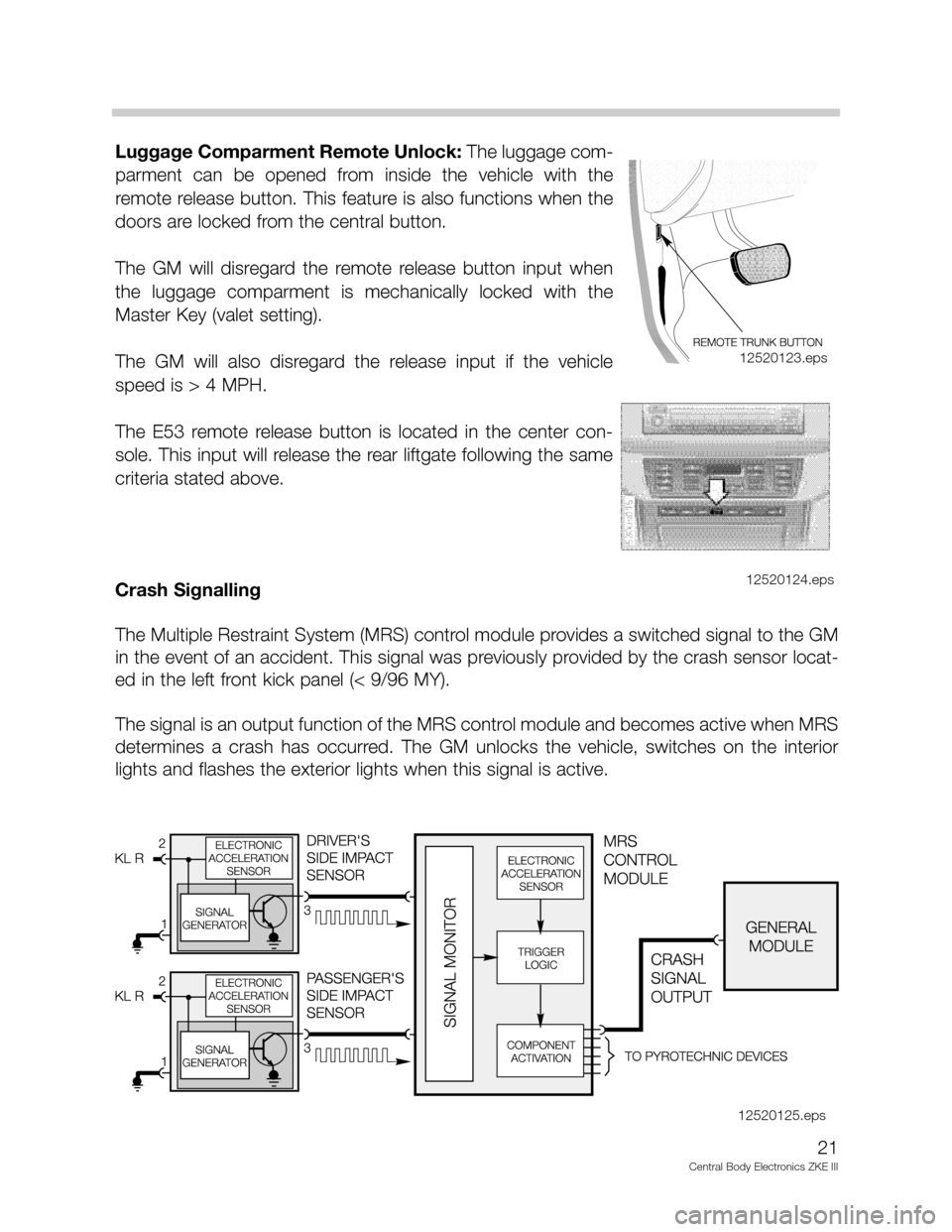
Luggage Comparment Remote Unlock: The luggage com-
parment can be opened from inside the vehicle with the
remote release button. This feature is also functions when the
doors are locked from the central button.
The GM will disregard the remote release button input when
the luggage comparment is mechanically locked with the
Master Key (valet setting).
The GM will also disregard the release input if the vehicle
speed is > 4 MPH.
The E53 remote release button is located in the center con-
sole. This input will release the rear liftgate following the same
criteria stated above.
Crash Signalling
The Multiple Restraint System (MRS) control module provides a switched signal to the GM
in the event of an accident. This signal was previously provided by the crash sensor locat-
ed in the left front kick panel (< 9/96 MY).
The signal is an output function of the MRS control module and becomes active when MRS
determines a crash has occurred. The GM unlocks the vehicle, switches on the interior
lights and flashes the exterior lights when this signal is active.
21
Central Body Electronics ZKE III
12520123.eps
12520124.eps
12520125.eps
Page 25 of 80
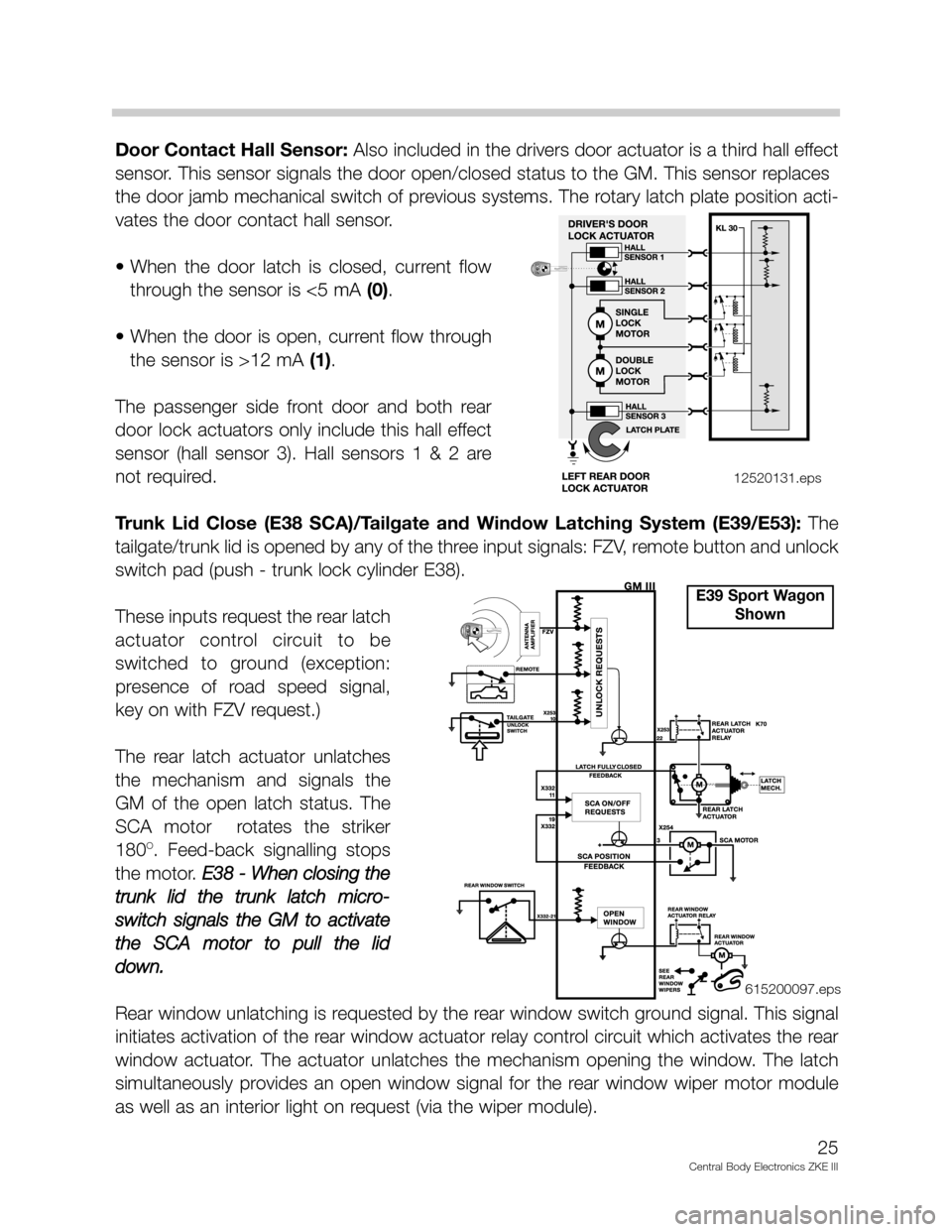
Door Contact Hall Sensor: Also included in the drivers door actuator is a third hall effect
sensor. This sensor signals the door open/closed status to the GM. This sensor replaces
the door jamb mechanical switch of previous systems. The rotary latch plate position acti-
vates the door contact hall sensor.
• When the door latch is closed, current flow
through the sensor is <5 mA (0).
• When the door is open, current flow through
the sensor is >12 mA (1).
The passenger side front door and both rear
door lock actuators only include this hall effect
sensor (hall sensor 3). Hall sensors 1 & 2 are
not required.
Trunk Lid Close (E38 SCA)/Tailgate and Window Latching System (E39/E53): The
tailgate/trunk lid is opened by any of the three input signals: FZV, remote button and unlock
switch pad (push - trunk lock cylinder E38).
These inputs request the rear latch
actuator control circuit to be
switched to ground (exception:
presence of road speed signal,
key on with FZV request.)
The rear latch actuator unlatches
the mechanism and signals the
GM of the open latch status. The
SCA motor rotates the striker
180
O. Feed-back signalling stops
the motor. E38 - When closing the
trunk lid the trunk latch micro-
switch signals the GM to activate
the SCA motor to pull the lid
down.
Rear window unlatching is requested by the rear window switch ground signal. This signal
initiates activation of the rear window actuator relay control circuit which activates the rear
window actuator. The actuator unlatches the mechanism opening the window. The latch
simultaneously provides an open window signal for the rear window wiper motor module
as well as an interior light on request (via the wiper module).
25
Central Body Electronics ZKE III
12520131.eps
E39 Sport Wagon
Shown
615200097.eps
Page 33 of 80
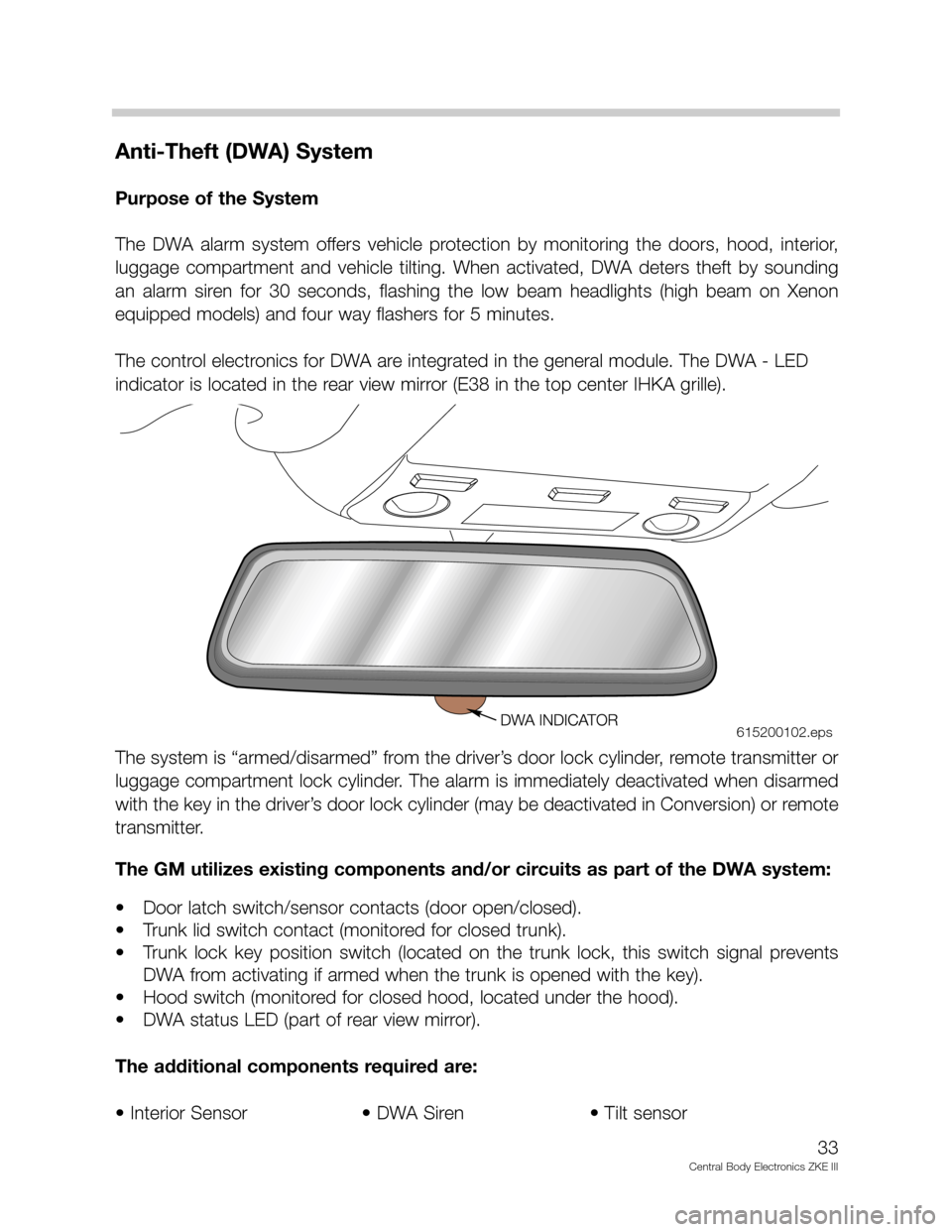
Anti-Theft (DWA) System
Purpose of the System
The DWA alarm system offers vehicle protection by monitoring the doors, hood, interior,
luggage compartment and vehicle tilting. When activated, DWA deters theft by sounding
an alarm siren for 30 seconds, flashing the low beam headlights (high beam on Xenon
equipped models) and four way flashers for 5 minutes.
The control electronics for DWA are integrated in the general module. The DWA - LED
indicator is located in the rear view mirror (E38 in the top center IHKA grille).
The system is “armed/disarmed” from the driver’s door lock cylinder, remote transmitter or
luggage compartment lock cylinder. The alarm is immediately deactivated when disarmed
with the key in the driver’s door lock cylinder (may be deactivated in Conversion) or remote
transmitter.
The GM utilizes existing components and/or circuits as part of the DWA system:
• Door latch switch/sensor contacts (door open/closed).
• Trunk lid switch contact (monitored for closed trunk).
• Trunk lock key position switch (located on the trunk lock, this switch signal prevents
DWA from activating if armed when the trunk is opened with the key).
• Hood switch (monitored for closed hood, located under the hood).
• DWA status LED (part of rear view mirror).
The additional components required are:
• Interior Sensor • DWA Siren • Tilt sensor
33
Central Body Electronics ZKE III
615200102.eps
Page 51 of 80
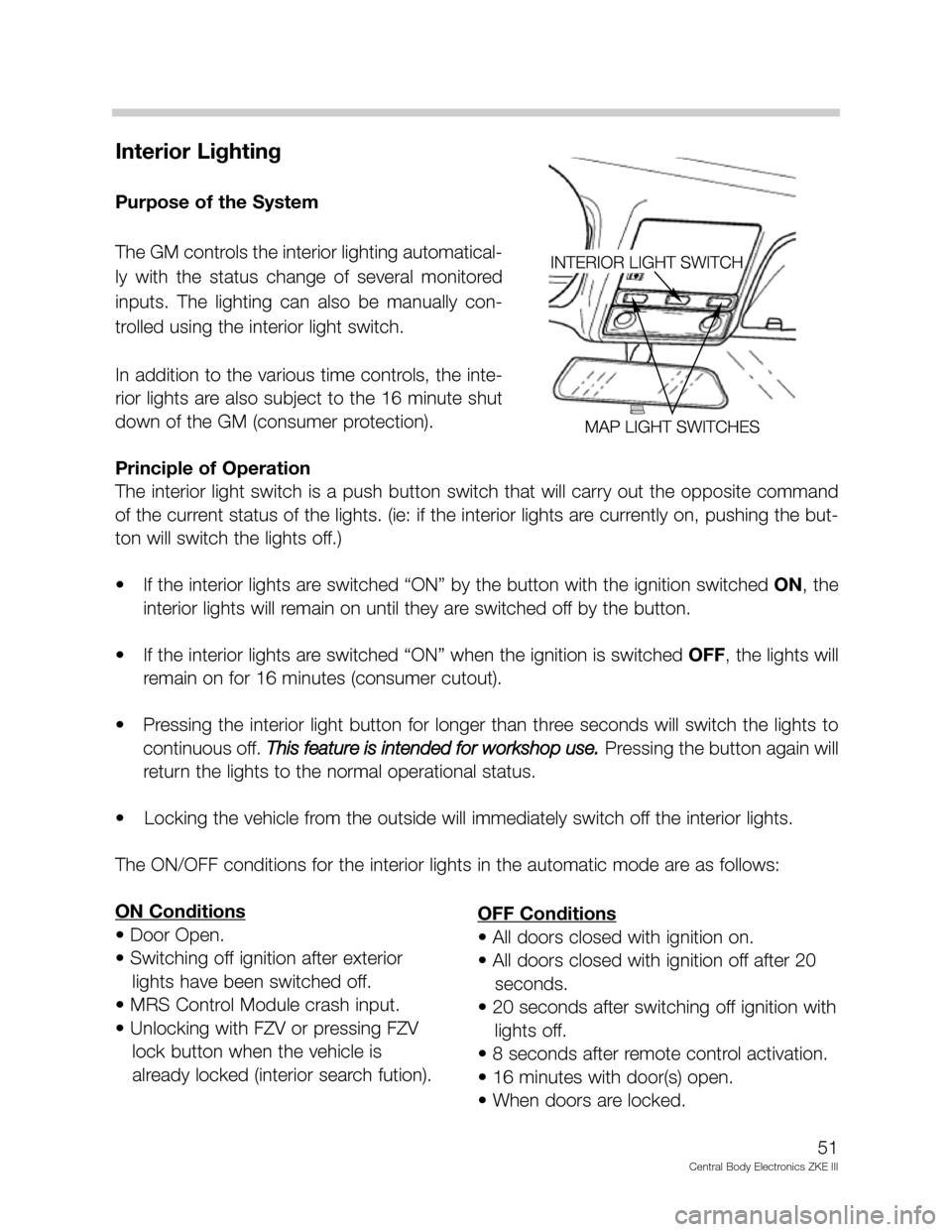
Interior Lighting
Purpose of the System
The GM controls the interior lighting automatical-
ly with the status change of several monitored
inputs. The lighting can also be manually con-
trolled using the interior light switch.
In addition to the various time controls, the inte-
rior lights are also subject to the 16 minute shut
down of the GM (consumer protection).
Principle of Operation
The interior light switch is a push button switch that will carry out the opposite command
of the current status of the lights. (ie: if the interior lights are currently on, pushing the but-
ton will switch the lights off.)
• If the interior lights are switched “ON” by the button with the ignition switched ON, the
interior lights will remain on until they are switched off by the button.
• If the interior lights are switched “ON” when the ignition is switched OFF, the lights will
remain on for 16 minutes (consumer cutout).
• Pressing the interior light button for longer than three seconds will switch the lights to
continuous off. This feature is intended for workshop use.
Pressing the button again will
return the lights to the normal operational status.
• Locking the vehicle from the outside will immediately switch off the interior lights.
The ON/OFF conditions for the interior lights in the automatic mode are as follows:
ON Conditions
• Door Open.
• Switching off ignition after exterior
lights have been switched off.
• MRS Control Module crash input.
• Unlocking with FZV or pressing FZV
lock button when the vehicle is
already locked (interior search fution).
51
Central Body Electronics ZKE III
OFF Conditions
• All doors closed with ignition on.
• All doors closed with ignition off after 20
seconds.
• 20 seconds after switching off ignition with
lights off.
• 8 seconds after remote control activation.
• 16 minutes with door(s) open.
• When doors are locked.
Page 53 of 80
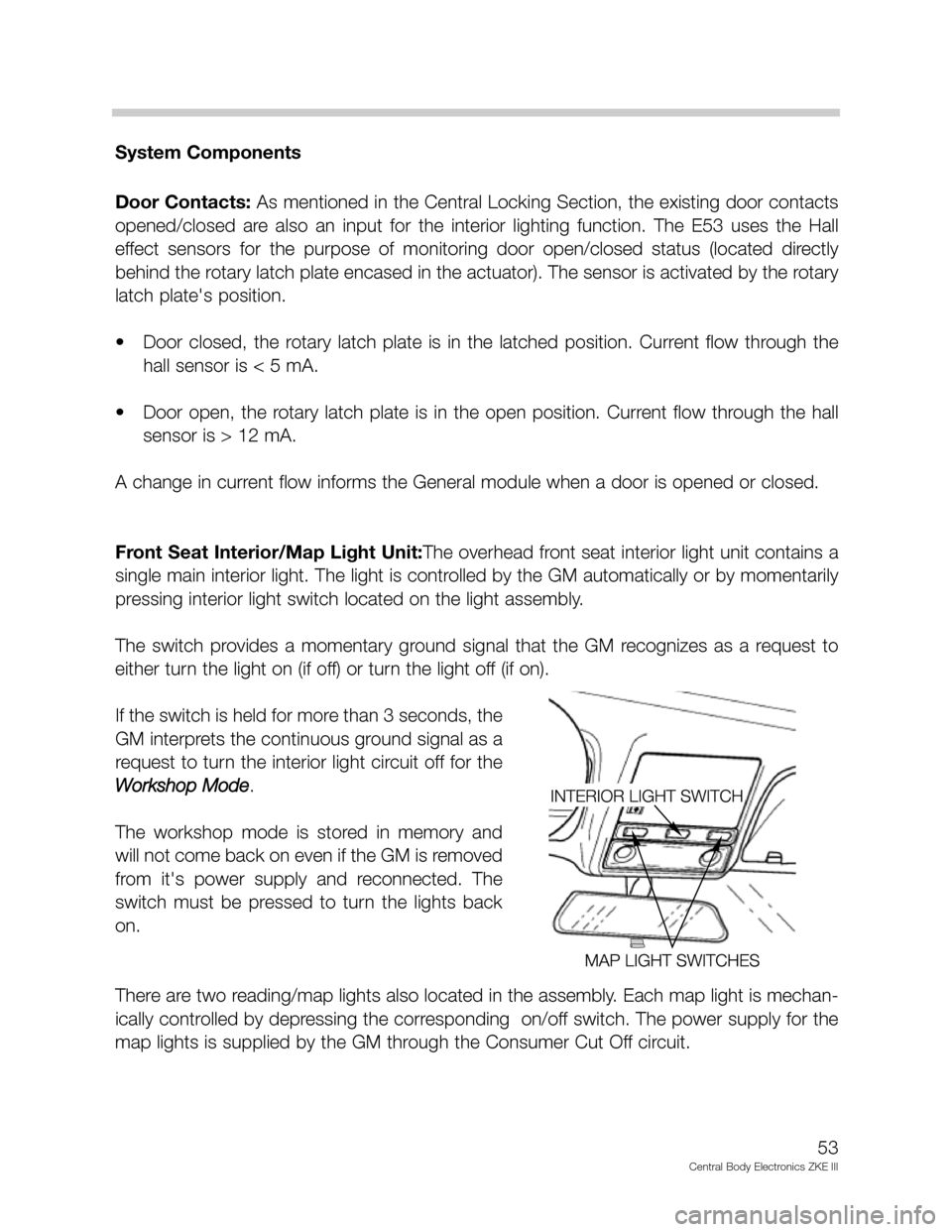
System Components
Door Contacts: As mentioned in the Central Locking Section, the existing door contacts
opened/closed are also an input for the interior lighting function. The E53 uses the Hall
effect sensors for the purpose of monitoring door open/closed status (located directly
behind the rotary latch plate encased in the actuator). The sensor is activated by the rotary
latch plate's position.
• Door closed, the rotary latch plate is in the latched position. Current flow through the
hall sensor is < 5 mA.
• Door open, the rotary latch plate is in the open position. Current flow through the hall
sensor is > 12 mA.
A change in current flow informs the General module when a door is opened or closed.
Front Seat Interior/Map Light Unit:The overhead front seat interior light unit contains a
single main interior light. The light is controlled by the GM automatically or by momentarily
pressing interior light switch located on the light assembly.
The switch provides a momentary ground signal that the GM recognizes as a request to
either turn the light on (if off) or turn the light off (if on).
If the switch is held for more than 3 seconds, the
GM interprets the continuous ground signal as a
request to turn the interior light circuit off for the
Workshop Mode
.
The workshop mode is stored in memory and
will not come back on even if the GM is removed
from it's power supply and reconnected. The
switch must be pressed to turn the lights back
on.
There are two reading/map lights also located in the assembly. Each map light is mechan-
ically controlled by depressing the corresponding on/off switch. The power supply for the
map lights is supplied by the GM through the Consumer Cut Off circuit.
53
Central Body Electronics ZKE III
Page 55 of 80
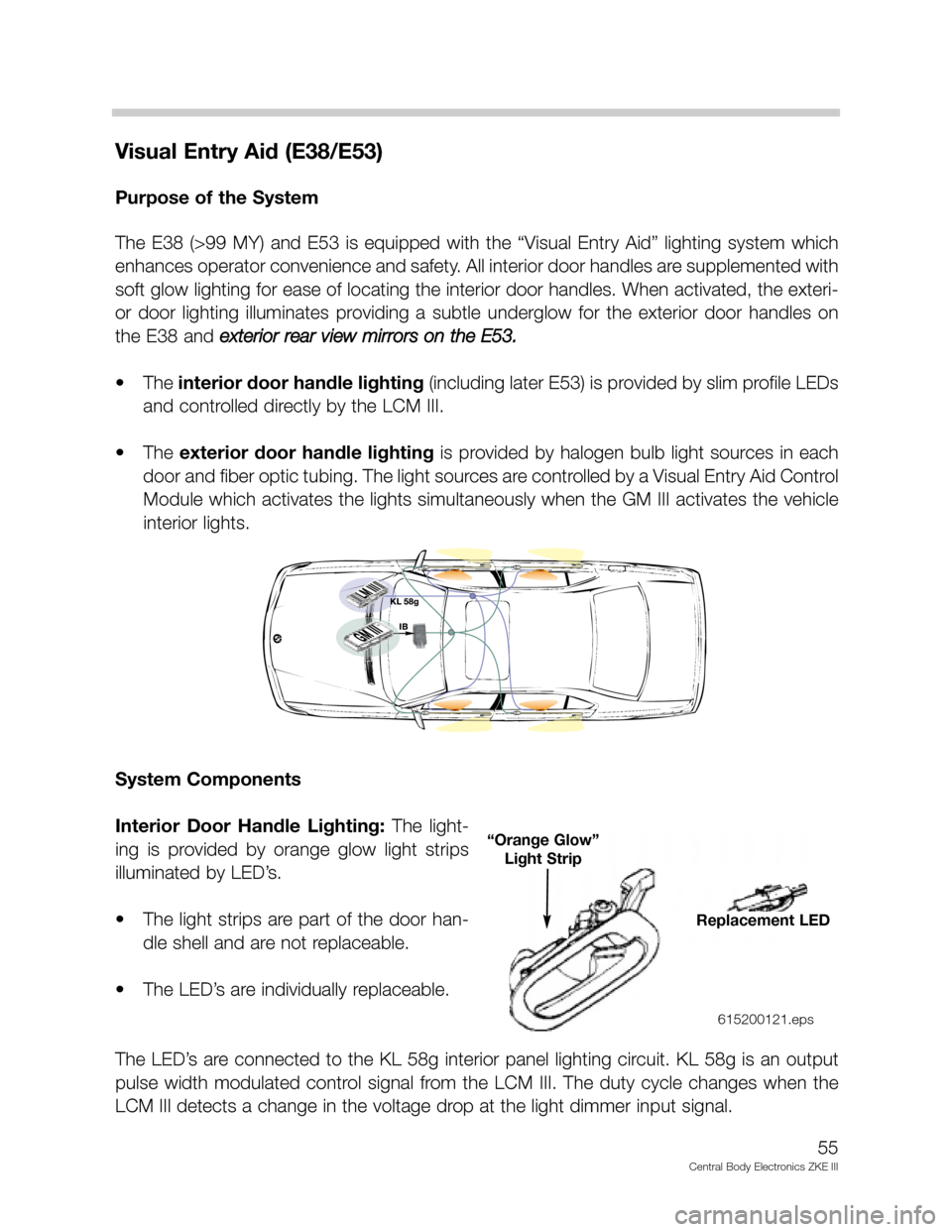
Visual Entry Aid (E38/E53)
Purpose of the System
The E38 (>99 MY) and E53 is equipped with the “Visual Entry Aid” lighting system which
enhances operator convenience and safety. All interior door handles are supplemented with
soft glow lighting for ease of locating the interior door handles. When activated, the exteri-
or door lighting illuminates providing a subtle underglow for the exterior door handles on
the E38 and exterior rear view mirrors on the E53.
• The interior door handle lighting(including later E53) is provided by slim profile LEDs
and controlled directly by the LCM III.
• The exterior door handle lightingis provided by halogen bulb light sources in each
door and fiber optic tubing. The light sources are controlled by a Visual Entry Aid Control
Module which activates the lights simultaneously when the GM III activates the vehicle
interior lights.
System Components
Interior Door Handle Lighting: The light-
ing is provided by orange glow light strips
illuminated by LED’s.
• The light strips are part of the door han-
dle shell and are not replaceable.
• The LED’s are individually replaceable.
The LED’s are connected to the KL 58g interior panel lighting circuit. KL 58g is an output
pulse width modulated control signal from the LCM III. The duty cycle changes when the
LCM III detects a change in the voltage drop at the light dimmer input signal.
55
Central Body Electronics ZKE III
Replacement LED
“Orange Glow”
Light Strip
615200121.eps
Page 56 of 80
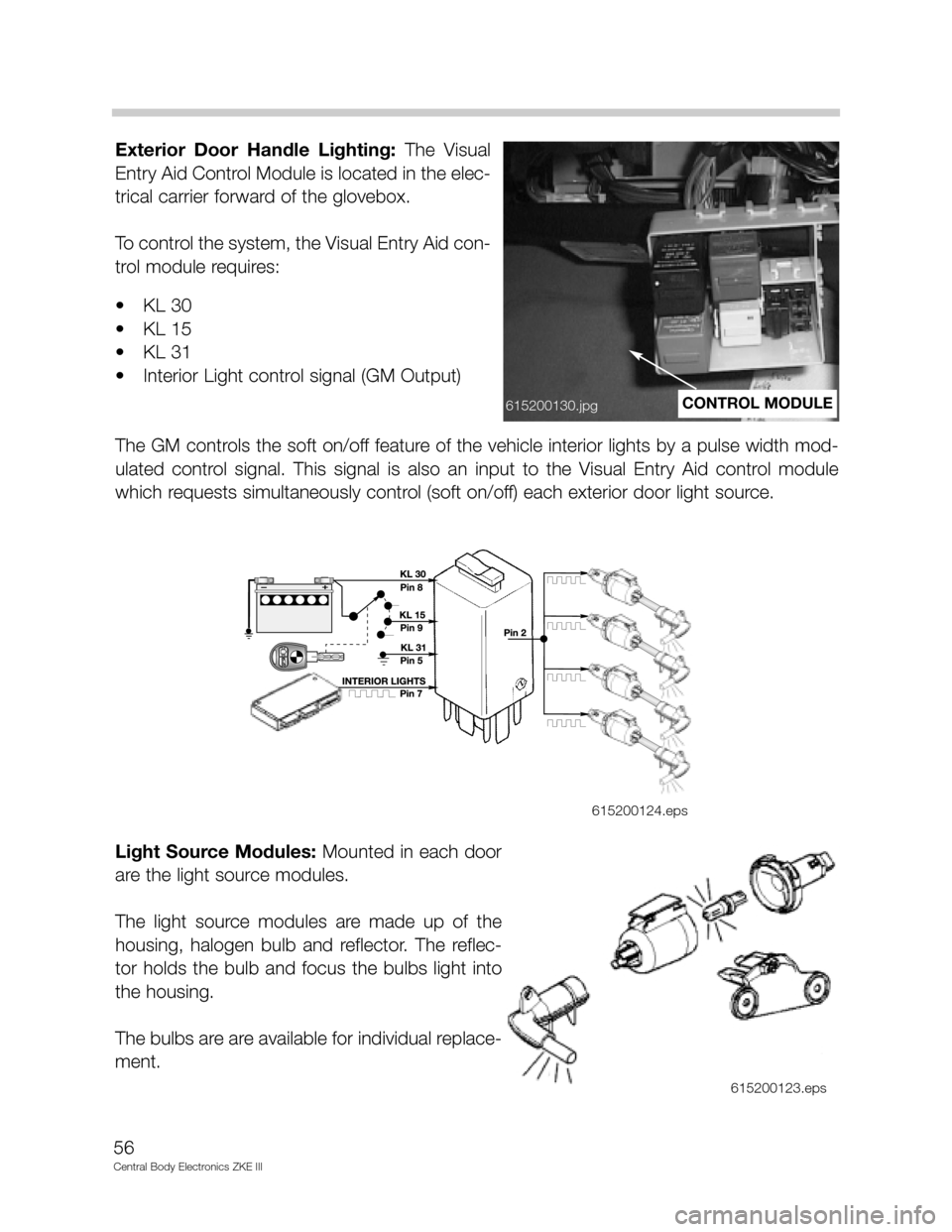
Exterior Door Handle Lighting: The Visual
Entry Aid Control Module is located in the elec-
trical carrier forward of the glovebox.
To control the system, the Visual Entry Aid con-
trol module requires:
• KL 30
• KL 15
• KL 31
• Interior Light control signal (GM Output)
The GM controls the soft on/off feature of the vehicle interior lights by a pulse width mod-
ulated control signal. This signal is also an input to the Visual Entry Aid control module
which requests simultaneously control (soft on/off) each exterior door light source.
Light Source Modules: Mounted in each door
are the light source modules.
The light source modules are made up of the
housing, halogen bulb and reflector. The reflec-
tor holds the bulb and focus the bulbs light into
the housing.
The bulbs are are available for individual replace-
ment.
56
Central Body Electronics ZKE III
CONTROL MODULE
615200123.eps 615200124.eps 615200130.jpg